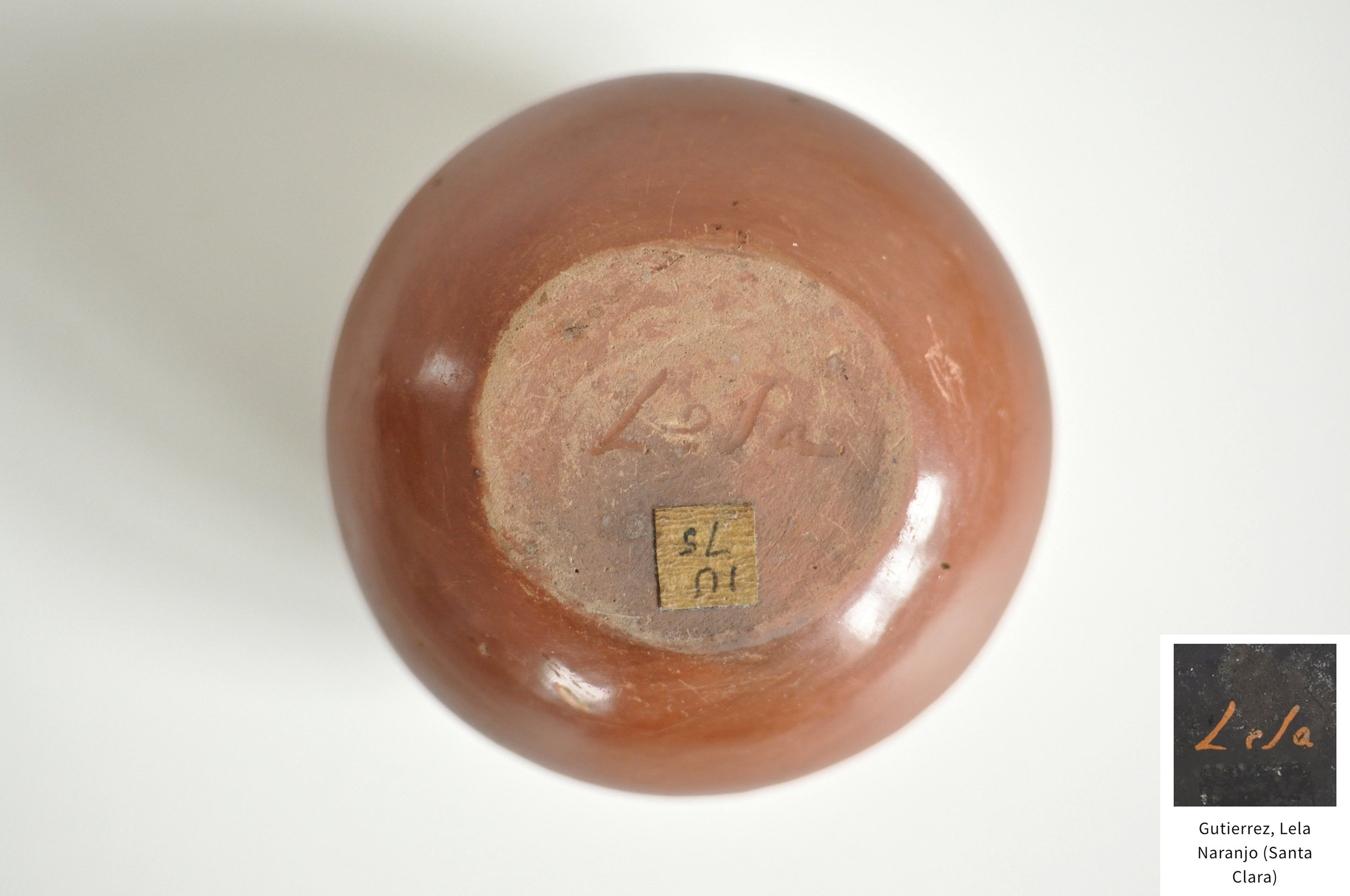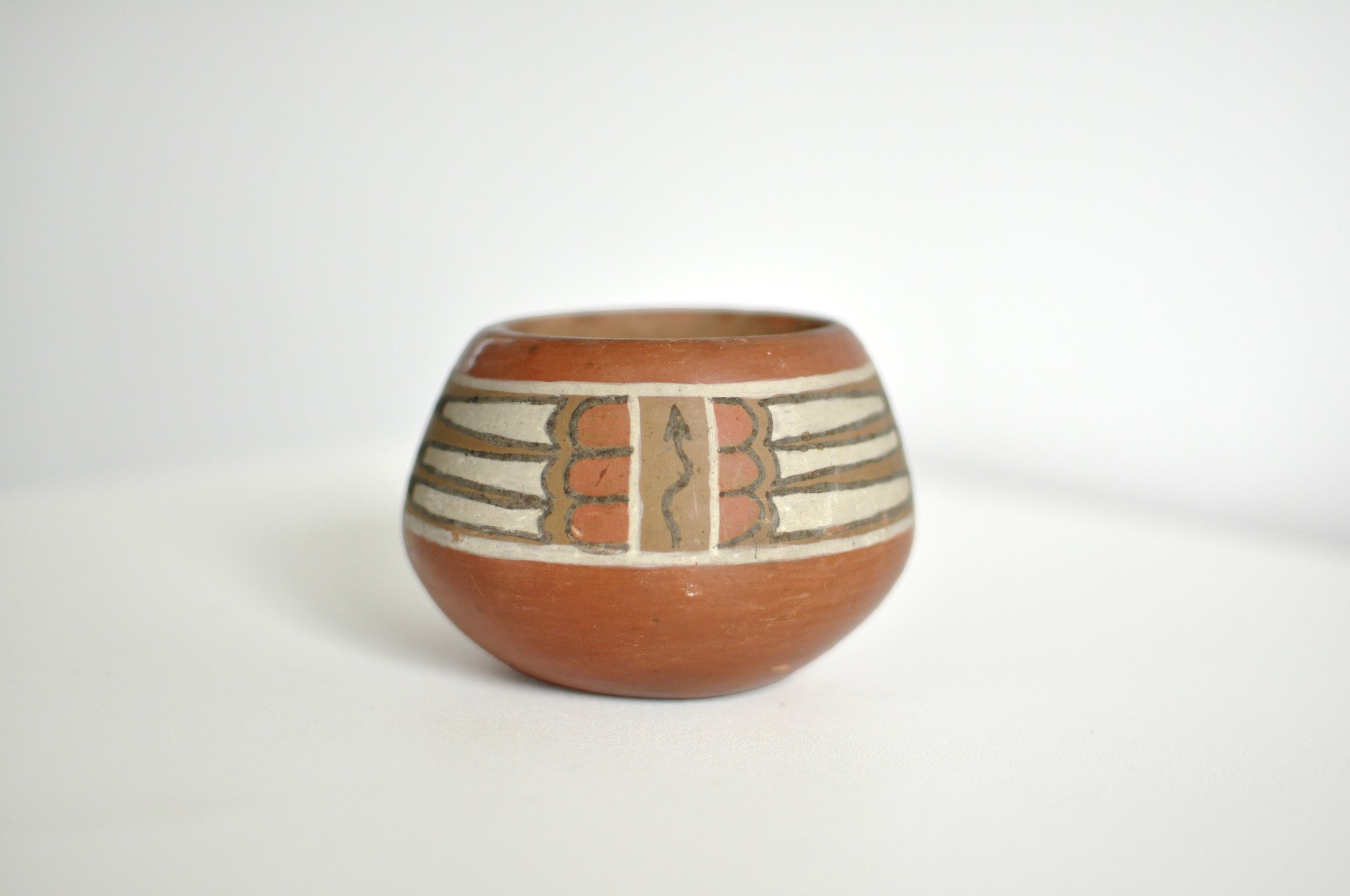Exceptional 1930s- 1940s Polychrome Offering Bowl by Lela Naranjo Gutierrez (1895-1966) of Santa Clara Pueblo New Mexico
This exceptional, small redware clay pot, was made by one of the leading figures in early 20th century Native American Pueblo pottery, Lela Naranjo Gutierrez (1895-1966) and is a very rare example of her early work. From the Santa Clara Pueblo (Kha’p’oo Owinge) - Valley of the Wild Roses, it was acquired by us along with other items, from the estate of an English collector.
Featuring a central band consisting of three horizontal feathered triangles, three arcs and a central arrow motif to two sides, it is a wonderful example of Lela’s groundbreaking style for the Santa Clara Pueblo. It is said that triangles represent growth and upward movement, arcs are interpreted as blessings and arrows imply force, movement, direction and power.
A genuine historical collectors piece, it dates to between the 1930s and 1940s and features stunning matte coloured pigments, outlined by black and white slip; traditionally made, using the coil and pinch method, with local clay gathered by the artist. It has been hand burnished to its rim and base and traditionally pit fired and is incised with the signature ‘Lela’ to its base.
This is a truly unique opportunity, to acquire a beautiful display piece, or a stunning addition for any collector of authentic, vintage Pueblo pottery.
Artist History:
Lela Naranjo Gutierrez (1895-1966) is world renowned as one of the seven matriarchs, in the ‘Seven Families in Pueblo’, a 1974 exhibition by the Maxwell Museum of Anthropology at the University of New Mexico. This singular exhibition that showcased New Mexico artists had a profound effect on the lives of Native American potters and propelled the seven families into fame and fortune as leaders in their people's pottery movement.
Lela began making pottery in the 1930’s, her early pieces are signed “Lela’, later working with her husband, Van Gutierrez (c1870-1956) when they began signing their works Lela - Van. Lela and her husband, were true pottery innovators in the Santa Clara Pueblo and their children carried on the tradition after their passing.
Both Lela and her husband tested many ideas in pottery making, but only when they developed a decorative scheme featuring earth colours on a matte background, did they achieve a process which was an enduring success. Bold curvilinear designs on a neutral tan or beige became the base for a new Santa Clara style. Santa Clara Pueblo straddles the Rio Grande located 25 miles north of Santa Fe.
Year of manufacture:
c. 1930-40s
Condition:
In excellent condition throughout free of notable damage. Light surface wear in line with age and the odd tiny flea nibble to its surface. Please note that historic Pueblo pottery is not to be used with, or around water.
Approximate Measurements:
10cm diameter at widest x 7cm H
Postage & Packaging:
As per our brand ethos, your item will be very carefully and securely shipped, wrapped with the utmost care in sustainable recycled and recyclable packaging.
We are proud to be PLASTIC FREE and you can compost our biodegradable bubble wrap too!
This exceptional, small redware clay pot, was made by one of the leading figures in early 20th century Native American Pueblo pottery, Lela Naranjo Gutierrez (1895-1966) and is a very rare example of her early work. From the Santa Clara Pueblo (Kha’p’oo Owinge) - Valley of the Wild Roses, it was acquired by us along with other items, from the estate of an English collector.
Featuring a central band consisting of three horizontal feathered triangles, three arcs and a central arrow motif to two sides, it is a wonderful example of Lela’s groundbreaking style for the Santa Clara Pueblo. It is said that triangles represent growth and upward movement, arcs are interpreted as blessings and arrows imply force, movement, direction and power.
A genuine historical collectors piece, it dates to between the 1930s and 1940s and features stunning matte coloured pigments, outlined by black and white slip; traditionally made, using the coil and pinch method, with local clay gathered by the artist. It has been hand burnished to its rim and base and traditionally pit fired and is incised with the signature ‘Lela’ to its base.
This is a truly unique opportunity, to acquire a beautiful display piece, or a stunning addition for any collector of authentic, vintage Pueblo pottery.
Artist History:
Lela Naranjo Gutierrez (1895-1966) is world renowned as one of the seven matriarchs, in the ‘Seven Families in Pueblo’, a 1974 exhibition by the Maxwell Museum of Anthropology at the University of New Mexico. This singular exhibition that showcased New Mexico artists had a profound effect on the lives of Native American potters and propelled the seven families into fame and fortune as leaders in their people's pottery movement.
Lela began making pottery in the 1930’s, her early pieces are signed “Lela’, later working with her husband, Van Gutierrez (c1870-1956) when they began signing their works Lela - Van. Lela and her husband, were true pottery innovators in the Santa Clara Pueblo and their children carried on the tradition after their passing.
Both Lela and her husband tested many ideas in pottery making, but only when they developed a decorative scheme featuring earth colours on a matte background, did they achieve a process which was an enduring success. Bold curvilinear designs on a neutral tan or beige became the base for a new Santa Clara style. Santa Clara Pueblo straddles the Rio Grande located 25 miles north of Santa Fe.
Year of manufacture:
c. 1930-40s
Condition:
In excellent condition throughout free of notable damage. Light surface wear in line with age and the odd tiny flea nibble to its surface. Please note that historic Pueblo pottery is not to be used with, or around water.
Approximate Measurements:
10cm diameter at widest x 7cm H
Postage & Packaging:
As per our brand ethos, your item will be very carefully and securely shipped, wrapped with the utmost care in sustainable recycled and recyclable packaging.
We are proud to be PLASTIC FREE and you can compost our biodegradable bubble wrap too!
This exceptional, small redware clay pot, was made by one of the leading figures in early 20th century Native American Pueblo pottery, Lela Naranjo Gutierrez (1895-1966) and is a very rare example of her early work. From the Santa Clara Pueblo (Kha’p’oo Owinge) - Valley of the Wild Roses, it was acquired by us along with other items, from the estate of an English collector.
Featuring a central band consisting of three horizontal feathered triangles, three arcs and a central arrow motif to two sides, it is a wonderful example of Lela’s groundbreaking style for the Santa Clara Pueblo. It is said that triangles represent growth and upward movement, arcs are interpreted as blessings and arrows imply force, movement, direction and power.
A genuine historical collectors piece, it dates to between the 1930s and 1940s and features stunning matte coloured pigments, outlined by black and white slip; traditionally made, using the coil and pinch method, with local clay gathered by the artist. It has been hand burnished to its rim and base and traditionally pit fired and is incised with the signature ‘Lela’ to its base.
This is a truly unique opportunity, to acquire a beautiful display piece, or a stunning addition for any collector of authentic, vintage Pueblo pottery.
Artist History:
Lela Naranjo Gutierrez (1895-1966) is world renowned as one of the seven matriarchs, in the ‘Seven Families in Pueblo’, a 1974 exhibition by the Maxwell Museum of Anthropology at the University of New Mexico. This singular exhibition that showcased New Mexico artists had a profound effect on the lives of Native American potters and propelled the seven families into fame and fortune as leaders in their people's pottery movement.
Lela began making pottery in the 1930’s, her early pieces are signed “Lela’, later working with her husband, Van Gutierrez (c1870-1956) when they began signing their works Lela - Van. Lela and her husband, were true pottery innovators in the Santa Clara Pueblo and their children carried on the tradition after their passing.
Both Lela and her husband tested many ideas in pottery making, but only when they developed a decorative scheme featuring earth colours on a matte background, did they achieve a process which was an enduring success. Bold curvilinear designs on a neutral tan or beige became the base for a new Santa Clara style. Santa Clara Pueblo straddles the Rio Grande located 25 miles north of Santa Fe.
Year of manufacture:
c. 1930-40s
Condition:
In excellent condition throughout free of notable damage. Light surface wear in line with age and the odd tiny flea nibble to its surface. Please note that historic Pueblo pottery is not to be used with, or around water.
Approximate Measurements:
10cm diameter at widest x 7cm H
Postage & Packaging:
As per our brand ethos, your item will be very carefully and securely shipped, wrapped with the utmost care in sustainable recycled and recyclable packaging.
We are proud to be PLASTIC FREE and you can compost our biodegradable bubble wrap too!
U.K. Shipping:
This will be sent on a FREE Royal Mail Tracked and signed for service double boxed for additional protection.
International Shipping:
For International orders this will be at an additional cost, depending on your location. We are not responsible for buyers import costs, any additional taxes or fees, or any delays with international shipping. For all orders outside of the U.K. your item(s) will be placed on an International 'Tracked and signed' for service.
Buyers Guide:
It is very important to note, that all the pieces Roof + Roof sell are genuine pieces of age, each having a rich and varied past and are never sold as in new condition. With this in mind, minor blemishes, surface scratches, manufacturing flaws and a general sense of their age and history are naturally to be expected. We always try, to the best of our ability to honestly and clearly communicate an items condition, both in our description and photography, highlighting anything over and above what we perceive as ‘general age related wear and tear’.





















